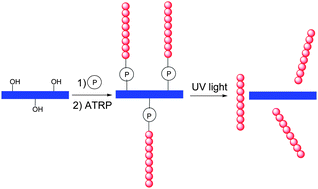Synthesis of cellulose nanocrystals bearing photocleavable grafts by ATRP†
Abstract
Cellulose

* Corresponding authors
a
INSA de Rouen, Polymères Biopolymères Surfaces CNRS UMR 6270 FR 3038, Avenue de l'université BP08, 76801 Saint Etienne du Rouvray cedex, France
E-mail:
gaelle.morandi@insa-rouen.fr
b
School of Chemistry, The University of Nottingham, University Park, Nottingham NG7 2RD, UK
E-mail:
wim.thielemans@nottingham.ac.uk
c Process and Environmental Research Division-Faculty of Engineering, The University of Nottingham, University Park, Nottingham NG7 2RD, UK
Cellulose

 Please wait while we load your content...
Something went wrong. Try again?
Please wait while we load your content...
Something went wrong. Try again?
G. Morandi and W. Thielemans, Polym. Chem., 2012, 3, 1402 DOI: 10.1039/C2PY20069D
To request permission to reproduce material from this article, please go to the Copyright Clearance Center request page.
If you are an author contributing to an RSC publication, you do not need to request permission provided correct acknowledgement is given.
If you are the author of this article, you do not need to request permission to reproduce figures and diagrams provided correct acknowledgement is given. If you want to reproduce the whole article in a third-party publication (excluding your thesis/dissertation for which permission is not required) please go to the Copyright Clearance Center request page.
Read more about how to correctly acknowledge RSC content.
 Fetching data from CrossRef.
Fetching data from CrossRef.
This may take some time to load.
Loading related content
